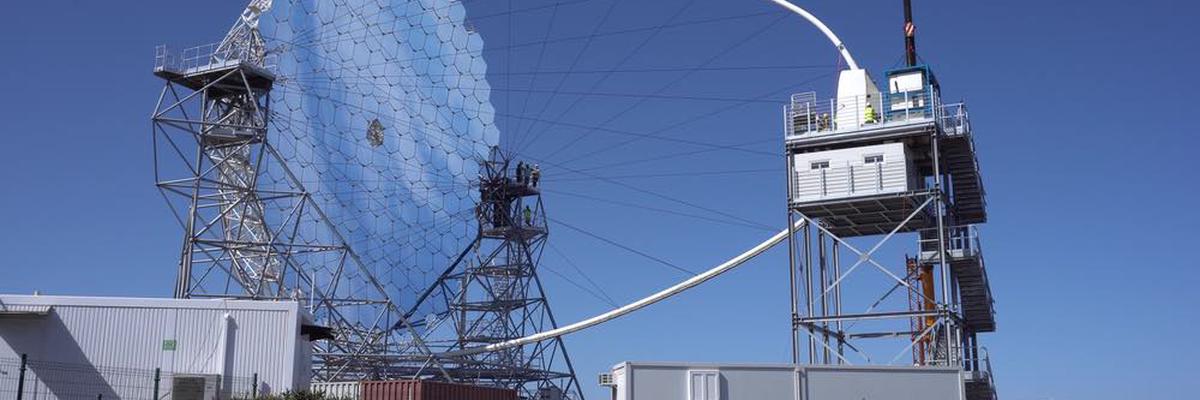Highlight
The First Telescope on a Cherenkov Telescope Array Site Makes its Debut
October 10, 2018

On Wednesday, 10 October 2018, more than 200 guests from around the world gathered on the northern array site of the Cherenkov Telescope Array (CTA) to celebrate the inauguration of the first prototype Large-Sized Telescope (LST). The telescope, named LST-1, is intended to become the first of four LSTs on the north site of the CTA Observatory, which is located on the existing site of the Instituto de Astrofisica de Canarias’ (IAC’s) Observatorio del Roque de los Muchachos located in the municipality of Villa de Garafia on the island of La Palma. The plan for the site also includes 15 Medium-Sized Telescopes (MSTs).
It was on 9 October 2015 that the first stone-laying ceremony took place for the LST-1. After the telescope foundation was completed in January 2017, the team moved swiftly and steadily toward its next major milestones: installation of the center pin and rails (September 2017), mounting of the dish (December 2017). In 2018, the LST-1 structure was completed in February and the camera support structure was installed in June. The final step, the camera installation, was completed on 25 September 2018.
The LST team consists of more than 200 scientists from ten countries: Brazil, Croatia, France, Germany, India, Italy, Japan, Poland, Spain and Sweden. In this truly international effort, the design and management leadership was shared among LAPP, Annecy, France; Max Planck Institute for Physics, Munich, Germany; INFN, Italy; ICRR, University of Tokyo, Japan; and IFAE, Barcelona and CIEMAT, Madrid, Spain.
In addition to the LST, two other classes of telescope are required to cover CTA’s full energy range from 20 gigaelectronvolt (GeV) to 300 teraelectronvolt (TeV): Medium-Sized Telescopes and Small-Sized Telescopes. Because gamma rays with low energies produce a small amount of Cherenkov light, telescopes with large mirrors are required to capture the images. Four LSTs will be arranged at the centre of both the northern and the southern hemisphere arrays of the Observatory to cover the low-energy sensitivity of CTA between 20 and 150 GeV.
The LST has a 23-metre diameter parabolic reflective surface, which is supported by a tubular structure made of reinforced carbon fibre and steel tubes. A reflective surface of 400 m2 collects and focuses the Cherenkov light into the camera, where photomultiplier tubes convert the light in electrical signals that can be processed by dedicated electronics. Although the LST-1 stands 45 metres tall and weighs around 100 tonnes, it is extremely nimble, with the ability to re-position within 20 seconds to capture brief, low-energy gamma-ray signals.
The LSTs will expand the science reach to cosmological distances and fainter sources with soft energy spectra.
Both the re-positioning speed and the low energy threshold provided by the LSTs are critical for CTA studies of transient gamma-ray sources in our own Galaxy and for the study of active galactic nuclei and gamma-ray bursts at high redshift.
The prototype is foreseen to become the first LST telescope of CTA, and, in fact, the first telescope on a CTA site, to be operated by the CTA Observatory (CTAO). As any other technical delivery in the large, multinational CTA project, the LST-1 will need to undergo a critical design review to verify that the design complies with CTA science goals, operational needs, safety standards, etc. before it is formally accepted by CTAO.
About CTA
CTA (www.cta-observatory.org ) is a global initiative to build the world’s largest and most sensitive high-energy gamma-ray observatory with about 120 telescopes split between two sites: one in the northern hemisphere at the Roque de los Muchachos astronomical observatory in the municipality of Villa de Garafia on the island of La Palma, Spain, and the other in the southern hemisphere near the existing European Southern Observatory site at Paranal, Chile. More than 1,400 scientists and engineers from 31 countries are engaged in the scientific and technical development of CTA. The planning for the construction of the Observatory is managed by the CTAO gGmbH, which is governed by Shareholders and Associate Members from a growing number of countries.
CTA will be the foremost global observatory for very high-energy gamma-ray astronomy over the next decade and beyond and will be the first ground-based gamma-ray astronomy observatory open to the world-wide astronomical and particle physics communities. The scientific potential of CTA is extremely broad: from understanding the role of relativistic cosmic particles to the search for dark matter. With its ability to cover an enormous range in photon energy from 20 GeV to 300 TeV, CTA will improve on all aspects of performance with respect to current instruments. CTA’s latest science case (published in 2017), Science with the Cherenkov Telescope Array, is available via the CTA website library (www.ctaobservatory.org/science/library/ ) and arXiv (1709.07997).
CTA was recently promoted to a landmark on the 2018 roadmap of the European Strategy Forum on Research Infrastructures (ESFRI). This project is receiving funding from the European Union’s Horizon 2020 research and innovation programs under agreement No 676134. This project has received funding from the European Union’s Seventh Framework Programme ([FP7/2007-2013] [FP7/2007-2011]) under Grant Agreement 262053.
- Additional Material
- LST-1 Inauguration webpage
- IFAE Research group
- Gamma-ray Group
- Contact
